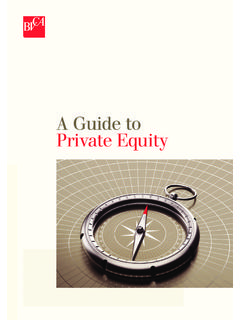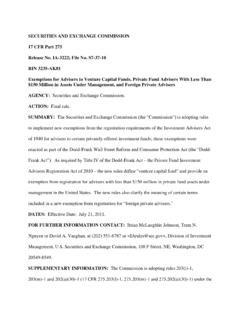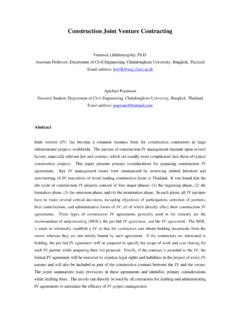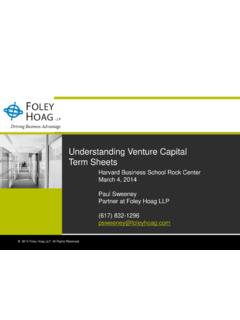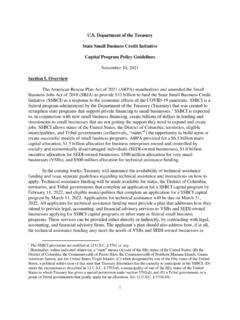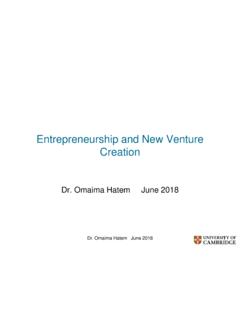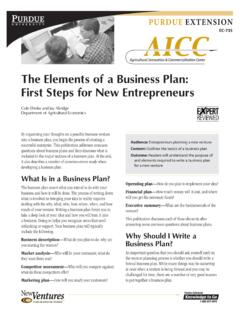Transcription of VENTURE CAPITAL 101
1 VENTURE CAPITAL 101 I. WHAT IS VENTURE CAPITAL ? VENTURE CAPITAL is money provided by an outside investor to finance a new, growing, or troubled business. The VENTURE capitalist provides the funding knowing that there s a significant risk associated with the company s future profits and cash flow. CAPITAL is invested in exchange for an equity stake in the business rather than given as a loan, and the investor hopes the investment will yield a better-than-average return. VENTURE CAPITAL is an important source of funding for start-up and other companies that have a limited operating history and don t have access to CAPITAL markets. A VENTURE CAPITAL firm (VC) typically looks for new and small businesses with a perceived long-term growth potential that will result in a large payout for investors. A VENTURE capitalist is not necessarily just one wealthy financier. Most VCs are limited partnerships that have a fund of pooled investment CAPITAL with which to invest in a number of companies.
2 They vary in size from firms that manage just a few million dollars worth of investments to much larger VCs that may have billions of dollars invested in companies all over the world. VCs may be a small group of investors or an affiliate or subsidiary of a large commercial bank, investment bank, or insurance company that makes investments on behalf clients of the parent company or outside investors. In any case, the VC aims to use its business knowledge, experience and expertise to fund and nurture companies that will yield a substantial return on the VC s investment, generally within three to seven years. Not all VC investments pay off. The failure rate can be quite high, and in fact, anywhere from 20 percent to 90 percent of portfolio companies may fail to return on the VC s investment. On the other hand, if a VC does well, a fund can offer returns of 300 to 1,000 percent. In additional to a portion of the equity, a VC expects to have a say in how its portfolio company operates.
3 Ideally, the VC fosters growth at the company through its involvement in managerial, strategic, and planning decisions. To do this, the VC relies on the expertise of its general partners who may be former CEOs, bankers, or experts in a particular industry. In most cases, one or more general partners of the VC take Board of Director positions at a portfolio company. They may also help recruit key executives to the portfolio company. 2 It s important to do your homework before approaching a VC for funding, to make sure you re targeting the right potential partner for your business needs. Not all VCs invest in start-ups. While some may invest small amounts of seed CAPITAL for very early ventures, many focus on early or expansion funding (see section III. Types of Funding), while still others may invest at the end of the business cycle, specializing in buyouts, turnarounds, or recapitalizations. VCs may be generalists that invest in a variety of industries and locations.
4 More typically, they specialize in a particular industry. Make sure your company falls within the VC s target industry before you make your pitch a VC that s focused on biotechnology start-ups will not consider your request for later-stage funding for expansion of your semiconductor firm. You can often gain insight into a VC s investment preferences by reviewing its website. In addition to industry preferences, VCs also typically have a geographic preference. Being in the same general location as a portfolio company allows the VC to better assist with business operations such as marketing, personnel, and financing. Keep in mind that VENTURE CAPITAL is not an option for all new businesses. In fact, VCs are very selective in choosing new companies to invest in, so your company may not qualify. They re most interested in businesses with high growth potential that will allow them to successfully exit with a higher than average return in a time frame of roughly three to 10 years, depending on the type of investment.
5 Given the rigorous expectations, most VENTURE funding goes to companies in rapidly expanding industries such as technology, biotechnology, and life sciences. There are some excellent alternatives to VENTURE CAPITAL that you should also explore in your search for funding sources. One such alternative is an angel investor a term for an investor that takes you under its wing and lifts you up to the next level of growth. Angel investors typically do not have deep pockets so the average investment tends to be smaller than that of a VC, typically hundreds of thousands of dollars rather than millions. For that amount of CAPITAL , proceed with caution if you re considering giving up some control over your company. For instance, it may not be wise to give a Board position to an angel investor who does not necessarily have the time, experience or expertise to make a significant contribution to your company. You might also consider a strategic investor partner in place of a VC investment.
6 This could be a vendor, customer, or other business partner with whom you re currently working, who might be interested in investing in your company. A strategic investor often has deeper pockets than an angel investor, but typically has a specific reason for investing in your company make sure you know the reason behind the investment. The 3 investor may only want to leverage your technology for its own purposes, which could have a negative impact on your business. Or, the investor may want a licensing distribution agreement if your company succeeds, which could benefit you. Make sure your interests are aligned. II. THE FUNDING PROCESS Step 1: Business Plan Submission The first step in approaching a VC is to submit a business plan. At minimum, your plan should include: 1. a description of the opportunity and market size; 2. resumes of your management team; 3. a review of the competitive landscape and solutions; 4. detailed financial projections; and 5.
7 A capitalization table. You should also include an executive summary of your business proposal along with the business plan. Once the VC has received your plan, it will discuss your opportunity internally and decide whether or not to proceed. This part of the process can take up to three weeks, depending on the number of business plans under review at any given time. Don t be passive about your submission. Follow up with the VC to check the status of your proposal and to find out if there s additional information you could be providing that might help the VC with its decision. If you are asked for further information, respond quickly and effectively. If possible, always try to get a face-to-face meeting with the VC. Keep in mind that most VCs receive an average of 200 business plans each month. Of those, less than five percent will be invited to meet with the VC s partners. Just two percent will reach the due diligence phase, and less than one percent will be offered a term sheet.
8 Some percent of those submitting a business plan will ultimately obtain VC funding. **The overwhelming majority of successful proposals come from a trusted referral of the VC, such as a limited partner, another VC, a known attorney or accountant, or other professional. If you can get your business plan referred by such a contact, you dramatically increase your odds of succeeding in getting VC funding. 4 Step 2: Introductory Conversation/Meeting If your firm has the potential to fit with the VC s investment preferences, you will be contacted in order to discuss your business in more depth. If, after this phone conversation, a mutual fit is still seen, you ll be asked to visit with the VC for a one- to-two hour meeting to discuss the opportunity in more detail. After this meeting, the VC will determine whether or not to move forward to the due diligence stage of the process. Step 3: Due Diligence The due diligence phase will vary depending upon the nature of your business proposal.
9 The process may last from three weeks to three months, and you should expect multiple phone calls, emails, management interviews, customer references, product and business strategy evaluations and other such exchanges of information during this time period. Step 4: Term Sheets and Funding If the due diligence phase is satisfactory, the VC will offer you a term sheet. This is a non-binding document that spells out the basic terms and conditions of the investment agreement. The term sheet is generally negotiable and must be agreed upon by all parties, after which you should expect a wait of roughly three to four weeks for completion of legal documents and legal due diligence before funds are made available. III. TYPES OF FUNDING The first professional investor to a deal at the start-up stage is referred to as the Series A investor. This investment is followed by middle and later stage funding the Series B, C, and D rounds. The final rounds include mezzanine, late stage and pre-IPO funding.
10 A VC may specialize in provide just one of these series of funding, or may offer funding for all stages of the business life cycle. It s important to know the preferences of the VC you re approaching, and to clearly articulate what type of funding you re seeking: 1. Seed CAPITAL . If you re just starting out and have no product or organized company yet, you would be seeking seed CAPITAL . Few VCs fund at this stage and the amount invested would probably be small. Investment CAPITAL may be used to create a sample product, fund market research, or cover administrative set-up costs. 2. Startup CAPITAL . At this stage, your company would have a sample product available with at least one principal working full-time. Funding at this stage is also rare. It tends to cover recruitment of other key management, additional market research, and finalizing of the product or service for introduction to the marketplace. 5 3. Early Stage CAPITAL . Two to three years into your VENTURE , you ve gotten your company off the ground, a management team is in place, and sales are increasing.

